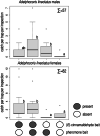Sex Pheromone of the Alfalfa Plant Bug, Adelphocoris lineolatus: Pheromone Composition and Antagonistic Effect of 1-Hexanol (Hemiptera: Miridae)
- PMID: 33871786
- PMCID: PMC8217015
- DOI: 10.1007/s10886-021-01273-y
Sex Pheromone of the Alfalfa Plant Bug, Adelphocoris lineolatus: Pheromone Composition and Antagonistic Effect of 1-Hexanol (Hemiptera: Miridae)
Abstract
The sex pheromone composition of alfalfa plant bugs, Adelphocoris lineolatus (Goeze), from Central Europe was investigated to test the hypothesis that insect species across a wide geographical area can vary in pheromone composition. Potential interactions between the pheromone and a known attractant, (E)-cinnamaldehyde, were also assessed. Coupled gas chromatography-electroantennography (GC-EAG) using male antennae and volatile extracts collected from females, previously shown to attract males in field experiments, revealed the presence of three physiologically active compounds. These were identified by coupled GC/mass spectrometry (GC/MS) and peak enhancement as hexyl butyrate, (E)-2-hexenyl butyrate and (E)-4-oxo-2-hexenal. A ternary blend of these compounds in a 5.4:9.0:1.0 ratio attracted male A. lineolatus in field trials in Hungary. Omission of either (E)-2-hexenyl-butyrate or (E)-4-oxo-2-hexenal from the ternary blend or substitution of (E)-4-oxo-2-hexenal by (E)-2-hexenal resulted in loss of activity. These results indicate that this Central European population is similar in pheromone composition to that previously reported for an East Asian population. Interestingly, another EAG-active compound, 1-hexanol, was also present in female extract. When 1-hexanol was tested in combination with the ternary pheromone blend, male catches were reduced. This compound showed a dose-response effect with small doses showing a strong behavioral effect, suggesting that 1-hexanol may act as a sex pheromone antagonist in A. lineolatus. Furthermore, when (E)-cinnamaldehyde was field tested in combination with the sex pheromone, there was no increase in male catch, but the combination attracted both males and females. Prospects for practical application are discussed.
Keywords: Adelphocoris lineolatus; Electroantennography; Field attraction; Miridae; Sex pheromone.
Conflict of interest statement
Not applicable.
Figures






References
-
- Benedek P, Erdélyi Cs, Jászai VE. Seasonal activity of Heteropterous species injurious to lucerne and its relations to the integrated pest control of lucerne grown for seed. Acta Phytopathol Acad Sci Hung. 1970;5:81–93.
-
- Birkett MA. The chemistry of plant signalling. In: Baluška F, Ninkovic V, editors. Plant communication from an ecological perspective. Berlin-Heidelberg: Springer; 2010. pp. 21–42.
-
- Boland W, Ney P, Jaenickea L, Gassmann G. A “closed-loop-stripping” technique as a versatile tool for metabolic studies of volatiles. In: Schreier P, editor. Analysis of volatiles. Berlin: Walter de Gruyter; 1984. pp. 371–380.
MeSH terms
Substances
Grants and funding
LinkOut - more resources
Full Text Sources
Other Literature Sources
Miscellaneous

